
COENZYM Q10 VE KERATIN İLE İLGİLİ BİLİMSEL ÇALIŞMALARA AİT REFERANSLAR
KERATİN'İN FAYDALARI HAKKINDA
- Kajiura Y, Watanabe S, Itou T, Nakamura K, Iida A, Inoue K, NYagi N, Shinohara Y, Amemiya Y. Mikrobeam SAXS taranarak insan saçı tek liflerinin yapısal analizi. J. Strut Biol. 2006; 155 (3): 438-444. doi: 10.1016 / j.jsb.2006.04.008. [ PubMed ] [ CrossRef ] [ Google Akademik ]
- Roddick-Lanzilotta A, Kelly R, Mitchell G, Chahal S. Saçı doğal keratin biyopolimerleriyle koruma. Cosm ve Toil. 2006; 121 (5): 61-68. [ Google Akademik ]
- Harrison S, Sinclair R. Saç boyama, kalıcı şekillendirme ve saç yapısı. J. Cosm Dermatol. 2003; 2 : 180–185. doi: 10.1111 / j.1473-2130.2004.00064.x. [ PubMed ] [ CrossRef ] [ Google Akademik ]
- Horev L. Saç dökülmesinde ve yıkılmasında çevresel ve kozmetik faktörler. Deri hastalıklarında çevresel faktörler. Curr Probl Dermatol Basel, Karger. 2007; 35 : 103-117. [ PubMed ] [ Google Akademik ]
- Araujo R, Fernandes M, Cavaco-Paulo A, Gomes A. İnsan saçı biyolojisi: Saçınızı kontrol etmeyi bilir. Adv Biochem Eng Biyoteknol. 2011; 125 : 121-143. [ PubMed ] [ Google Akademik ]
- Bolduc C, Shapiro J. Saç bakım ürünleri: sallama, düzleştirme, bakım ve renklendirme. Clin Dermatol. 2001; 19 (4): 431-436. doi: 10.1016 / S0738-081X (01) 00201-2. [ PubMed ] [ CrossRef ] [ Google Akademik ]
- Yuen CWM, Kan CW, Çeng SY. Keratin lifi hasarlarının değerlendirilmesi. Lifler ve Polimerler. 2007; 8 (4): 414-420. doi: 10.1007 / BF02875831. [ CrossRef ] [ Google Akademik ]
- Choulot JC. Doğal aktiflerle saçı onarır. Cosm Toil. 2012; 127 (1): 42-47. [ Google Akademik ]
- Sionkowska A, Skopinska-Wiśniewska J, Kozłowska J, Płanecka A, Kurzawa M. Hidrolize keratinin fotokimyasal davranışı. Int J Cosm Sci. 2011; 33 : 503–508. doi: 10.1111 / j.1468-2494.2011.00662.x. [ PubMed ] [ CrossRef ] [ Google Akademik ]
- Freis O, Gauchd D, Griesbach U, Haake HM. Düşük moleküler protein hidrolizatlarının saça nüfuz etmesini değerlendirmek için floresan lazer taramalı konfokal mikroskopi. Cosm Toil. 2010; 125 (11): 30-35. [ Google Akademik ]
- Hütter I. Düşük moleküler proteinlerle derinlemesine etki gösteren saç bakımı. SÖFW. 2003; 129 : 12-16. [ Google Akademik ]
- Barba C, Mendez S, Roddick-Lanzilotta A, Kelly R, Parra ve JL, Coderch L. Topikal olarak uygulanan hidrolize keratin peptidlerinin ve yünden elde edilen lipitlerin kozmetik etkinliği. Skin Res Technol. 2008; 14 : 243-248. doi: 10.1111 / j.1600-0846.2007.00280.x. [ PubMed ] [ CrossRef ] [ Google Akademik ]
- Niinimaki A, Niinimaki M, Makinen-Kiljunen S, Hannuksela M. Saç bakım ürünlerindeki protein hidrolizatlardan ürtiker ile temas kurun. Alerji. 1998; 53 : 1075-1082. [ PubMed ] [ Google Akademik ]
- Mazotto AM, Cedrola SLM, Lins U, Rosado AS, Silva KT, Chaves JQ, Rabinovitch L, Zingali RB, Vermelho AB. İnsan saçı kullanılarak Bacillus subtilis AMR'nin keratinolitik aktivitesi . Lett Appl Microbiol. 2010; 50 : 89-96. doi: 10.1111 / j.1472-765X.2009.02760.x. [ PubMed ] [ CrossRef ] [ Google Akademik ]
- Mazzotto AM, Melo CAN, Macrae A, Rosado A.Ş., Peixoto R, Cedrola SLM, Coury S, Zingali RB, Villa ALV, Rabinovitch L, Chaves JQ, Vermelho AB. Bacillu spp.'den ekstraselüler keratinazlar ve jelatinazlar ile tüy atığının biyolojik olarak parçalanması . Dünya J Microbiol Biotechnol. 2011; 27 : 1355-1365. doi: 10.1007 / s11274-010-0586-1. [ PubMed ] [ CrossRef ] [ Google Akademik ]
- Cedrola SML, Melo ACN, Mazotto AM, Lins U, Zingali RB, Rosado A.Ş., Peixoto RS, Vermelho AB. Tüy atığını geri dönüştürmek için Bacillus subtilis SLC'den keratinas ve sülfit . Dünya J Microbiol Biotechnol. 2012; 28 : 1259-1269. doi: 10.1007 / s11274-011-0930-0. [ PubMed ] [ CrossRef ] [ Google Akademik ]
- Mazotto AM, Coelho RRR, Cedrola SLM, Coury S, Souza, Vermelho AB. Üç bacillus spp. İle keratinaz üretimi . Suya daldırılmış bir fermantasyonda substrat olarak tüy unu ve bütün tüy kullanılması. Enzim Arş. 2011; 2011 : 1–7. [ PMC ücretsiz makale ] [ PubMed ] [ Google Akademik ]
- Karthikeyan R, Balaji S, Şehgal P. Keratinlerin endüstriyel uygulamaları - bir inceleme. J Sci Ind Res Hindistan. 2007; 66 : 710-715. [ Google Akademik ]
- Lowry OH, Rosembrough NJ, Farr AL, Randall RJ. Folin fenol maddesi ile Protein ölçümü. J Biol Chem. 1951 193 (1): 267-275. [ PubMed ] [ Google Akademik ]
- Vermelho AB, Noronha EF, Filho EDXF, Ferrara MA, Bon EPS. In: Prokaryotlar - Uygulamalı Bakteriyoloji ve Biyoteknoloji. Rosenberg, DeeLong EF, Lory S, Stackebrandt E, Thompson F, editör. Springer; 2013. Prokaryotik enzimler: çeşitlilik ve biyoteknolojik uygulamalar. [ Google Akademik ]
- Kananen A, Savolainen J, Mäkinen J, Pertillä U, Myllykowski L, Pihlanto-Leppäla A. Pepsin ve tripsin ile hidrolizde peynir altı suyu protein konformasyonunun kimyasal modifikasyonunun etkisi. Int Dairy J. 2000; 10 : 691-697. doi: 10.1016 / S0958-6946 (00) 00094-7. [ CrossRef ] [ Google Akademik ]
- Eremmeev NL, Nikolaev IV, Keruchen'ko Kimliği, Stepanova EV, Satrutdinov AD, Zinov'ev SV, İsmailova DIU, Khotchenkov VP, Tsurikova NV, Sinitsyn AP, Volik VG, Koroleva OV. Protein hidrolizatlarının elde edilmesi için keratin içeren stoğun enzimatik hidrolizi. Priki Biokhim Mikrobiol. 2009; 45 (6): 717-724. [ PubMed ] [ Google Akademik ]
- Gupta R, Sharma R, Beg QK. Mikrobiyal keratinazların tekrar gözden geçirilmesi: sürdürülebilir biyoteknoloji için yeni nesil proteazlar. Crit Rev Biotechnol. 2012; 30 : 1–13. [ PubMed ] [ Google Akademik ]
- Cai C, Lou B, Zheng X. Keratinaz üretimi ve bir Bacillus subtilis mutant suşu tarafından keratin bozulması . J Zhejiang Univ Sci B. 2008; 9 (1): 60-67. doi: 10.1631 / jzus.B061620. [ PMC ücretsiz makale ] [ PubMed ] [ CrossRef ] [ Google Akademik ]
- Rajput R, Sharma R, Gupta R. Bacillus pumilus KS12'den tiyol ile aktive edilmiş, oksidasyona kararlı keratinazın biyokimyasal karakterizasyonu . Enzim Arş. 2010; 201 : 132148. [ PMC ücretsiz makale ] [ PubMed ] [ Google Akademik ]
- Agrah S, Wadhwa N. ghazipur kümes hayvanı atık bölgesinden izole edilen bacillus megaterium SN1'den tüy tüy bozucu enzimlerin izolasyonu ve karakterizasyonu . Appl Biochem Microbiol. 2012; 48 (2): 175-181. doi: 10.1134 / S0003683812020020. [ PubMed ] [ CrossRef ] [ Google Akademik ]
- Matsui T, Yamada Y, Mitsuya H, Shigeri Y, Yoshida Y, Saito Y, Matsui H, Watanabe K. Sürdürülebilir tavuk tüylerinin yeni bir izole edilmiş termofilik Meiothermus ruber H328'i geliştirerek sürekliliği ve pratik şekilde bozulması . Appl Microbiol Biot. 2009; 82 : 941-950. doi: 10.1007 / s00253-009-1880-4. [ PubMed ] [ CrossRef ] [ Google Akademik ]
- Tiedtke J. Cilt ve saç bakımı için çok işlevli bir bitki proteini. Cosm Sci Technol. 2008. s. 15–26.
- Hachiro T, Yuko K, Kunio I, Shoko S, Fumio I, Keiji I, Kohdo Y, Mizuho Y. Stratum korneumun fonksiyonel değerlendirilmesi için cildin su emme-desorpsiyon testi. J Invest Dermatol. 1982; 78 : 425-428. doi: 10.1111 / 1523-1747.ep12507756. [ PubMed ] [ CrossRef ] [ Google Akademik ]
- Langmaier F, Mladek M, Kolomaznik K, Sukop S. Geleneksel olmayan protein kaynaklarından gelen kollajen hidrolizatları. Int J Cosm Sci. 2001; 23 : 193-199. doi: 10.1046 / j.0412-5463.2001.00081.x. [ PubMed ] [ CrossRef ] [ Google Akademik ]
- Sá Dias TC, Bebek AR, Kaneko TM, Velasco MVR. Afro-etnik saçların gevşetilmesi / düzeltilmesi: tarihsel bakış. J. Cosm Dermatol. 2007; 6 : 2-5. [ PubMed ] [ Google Akademik ]
- Galliano A, Aziz Zeytin Baque C, Marty G, Nedelec B, Gauchet L, Littaye P, Gu W, Huguet E, Querleux B, Silberzan L, Kravtchenko S, Kempf JY. Islak koşullarda bir çalkalama işleminden sonra insan saç kütikülünün direnci: Çin ve Kafkas kılları arasındaki karşılaştırma. Int J Cosmet Sci. 2010; 32 : 356-368. doi: 10.1111 / j.1468-2494.2009.00563.x. [ PubMed ] [ CrossRef ] [ Google Akademik ]
- Cao ZJ, LuD, Luo, LS, Deng YX, Bian YG, Zhang XQ, Zhou MH. Kompozisyon analizi ve bütün tüylerin bozunma ürünlerinin büyük bir fermantasyon ölçeğiyle uygulanması. Environmental Sci Pollut Arş. 2012; 19 (7) [ PubMed ] [ Google Akademik ]
- Brandelli A. Bakteriyel keratinazlar: tarımsal sanayi yan ürünlerinden ve ötesinden biyopro556 bırakması için faydalı enzimler. Gıda Biyoproses Teknolojisi. 2008; 1 : 105-116. doi: 10.1007 / s11947-007-0025-y. [ CrossRef ] [ Google Akademik ]
- Gurav RG, Jadhav JP. Keratin atıklarının Chryseobacterium sp. Kanatlı atıklarıyla kirlenmiş topraktan izole edilmiş RBT. J Temel Mikrobiyol. 2013. [ PubMed ]
- Sahoo DK, Das A, Thatoi H, Mondal KC, Mohapatra PK. Toz haline getirilmiş fermantasyon altında yeni izole edilmiş bir bakteri tarafından bütün tavuk tüyü keratinin keratinaz üretimi ve biyolojik olarak parçalanması. Appl Biochem Biotechnol. 2012; 167 (5): 1040–51. doi: 10.1007 / s12010-011-9527-1. [ PubMed ] [ CrossRef ] [ Google Akademik ]
COENZYME Q10'NİN FAYDALARI HAKKINDA
Pharmacological effects of Coenzyme Q10 reported in the literatüre
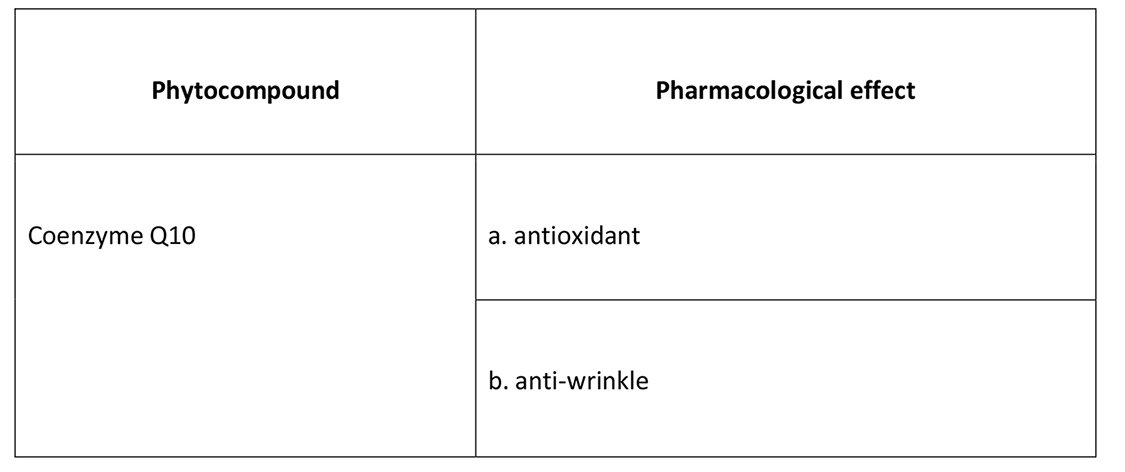
[1] Anja Knott, Volker Achterberg, Christoph Smuda, Heiko Mielke, Gabi Sperling, Katja Dunckelmann, Alexandra Vogelsang, Andrea Krüger, Helge Schwengler, Mojgan Behtash, Sonja Kristof, Heike Diekmann, Tanya Eisenberg, Andreas Berroth, Janosch Hildebrand, Ralf Siegner, Marc Winnefeld, Frank Teuber, Sven Fey, Janne Möbius, Dana Retzer, Thorsten Burkhardt, Juliane Lüttke, and Thomas Blatt Topical treatment with coenzyme Q10‐containing formulas improves skin's Q10 level and provides antioxidative effects
[2] Batisse D., Bazin R., Baldeweck T., Querleux B., and Lévêque J. L. (2002) Influence of age on the wrinkling capacities of skin.
[3] Escoffier C., de Rigal J., Rochefort A., Vasselet R., Lévêque J. L., and Agache P. G. (1989) Age‐related mechanical properties of human skin: an in vivo study.
[4] Harman D. (1956) Aging: a theory based on free radical and radiation chemistry. J. Gerontol. 11, 293–300.
[5] Sohal R. S. (1991) Hydrogen peroxide production by mitochondria may be a biomarker of aging. Mech. Ageing Dev. 60, 189–198.
[6] Zwerschke W., Mazurek S., Stöck lP., Hütter E., Eigenbrodt E., et al. (2003) Metabolic analysis of senescent human fibroblasts reveals a role for AMP in cellular senescence. Biochem. J. 376, 403–411.
[7] Scharffetter‐Kochanek K., Brenneisen P., Wenk J., Herrmann G., Ma W., et al. (2000) Photoaging of the skin from phenotype to mechanisms. Exp. Gerontol. 35, 307–316.
[8] Blatt T. and Littarru G. P. (2011) Biochemical rationale and experimental data on the antiaging properties of CoQ(10) at skin level. Biofactors 37, 381–385.
[9] Mitchell P. (1975) Protonmotive redox mechanisms of cytochrome b‐c1 complex in the respiratory chain: protonmotive ubiquinone cycle. FEBS Lett. 56, 1–6.
[10] Bentinger M., Tekle M., and Dallner G. (2010) Coenzyme Q ‐ biosynthesis and functions. Biochem. Biophys. Res. Commun. 396, 74–79.
[11] Gille L. and Nohl H. (2000) The existence of a lysosomal redox chain and the role of ubiquinone. Arch. Biochem. Biophys. 375, 347–354.
[12] Ernster L. and Dallner G. (1995) Biochemical, physiological and medical aspects of ubiquinone function. Biochim. Biophys. Acta 1271, 195–204.
[13] Hoppe U., Bergemann J., Diembeck W., Ennen J., Gohla S., et al. (1999) Coenzyme Q10, a cutaneous antioxidant and energizer. Biofactors 9, 371–378.
[14] Blatt T., Mundt C., Mummert C., Maksuik T., Wolber R., et al. (1999) Modulation des oxidativen Stresses in der humanen Altershaut. Z. Gerontol. Geriat. 32, 83–88.
[15] Prahl S., Kueper T., Biernoth T., Wöhrmann Y., Münster A., et al. (2008) Aging skin is functionally anaerobic: importance of conenzyme Q10 for anti aging skin care. Biofactors 32, 245–255. [16] Wang Y., Oxer D., and Hekimi S. (2015) Mitochondrial function and lifespan of mice with controlled ubiquinone biosynthesis. Nat. Commun. 6, 6393.
[17] Littarru G. P. and Tiano L. (2007) Bioenergetic and antioxidant properties of coenzyme Q10: recent developments. Mol. Biotechnol. 37, 31–37.
[18] Schmelzer C. and Döring F. (2012) Micronutrient special issue: coenzyme Q(10) requirements for DNA damage prevention. Mutat. Res. 733, 61–68.
[19] Podda M., Traber M. G., Weber C., Yan L. J., and Packer L. (1998) UV‐irradiation depletes antioxidants and causes oxidative damage in a model of human skin. Free Radic. Biol. Med. 24, 55–65.
20] Kiistala U. (1968) Suction blister device for separation of viable epidermis from dermis. J. Invest. Dermatol. 50, 129–137.
[21] Südel K. M., Venzke K., Knußmann‐Hartig E., Moll I., Stäb F., et al. (2003) Tight control of matrix metalloproteinase‐1 activity in human skin. Photochem. Photobiol. 78, 840–845.
[22] Palmieri B. and Sblendorio V. (2007) Oxidative stress tests: overview on reliability and use: part II. Eur. Rev. Med. Pharmacol. Sci. 11, 383–399.
[23] Kamhieh‐Milz J. and Salama A. (2014) Oxidative stress is predominant in female but not in male patients with autoimmune thrombocytopenia. Oxid. Med. Cell Longev., 2014; 2014:720347.
[24] Failla M. L., Chitchumroonchokchai C., and Aoki F. (2014) Increased bioavailability of ubiquinol compared to that of ubiquinone is due to more efficient micellarization during digestion and greater GSH‐dependent uptake and basolateral secretion by Caco‐2 cells. J. Agric. Food Chem. 62, 7174–7182.
[25] Bentinger M., Brismar K., and Dallner G. (2007) The antioxidant role of coenzyme Q. Mitochondrion 7(Suppl), S41–S50.
[26] Kwong L. K., Kamzalov S., Rebrin I., Bayne A. C., Jana C. K., et al. (2002) Effects of coenzyme Q(10) administration on its tissue concentrations, mitochondrial oxidant generation, and oxidative stress in the rat. Free Radic. Biol. Med. 33, 627–638.
[27] Passi S., de Pità S., Puddu O., and Littarru P. G. P. (2002) Lipophilic antioxidants in human sebum and aging. Free Radic. Res. 36, 471–477.
[28] Thiele J. J., Schroeter C., Hsieh S. N., Podda M., and Packer L. (2001) The antioxidant network of the stratum corneum. Curr. Probl. Dermatol. 29, 26–42.
[29] Kalén A., Appelkvist E. L., and Dallner G. (1989) Age‐related changes in the lipid compositions of rat and human tissues. Lipids 24, 579–584.
[30] Miles M. V., Horn P. S., Tang P. H., Morrison J. A., Miles L., et al. (2004) Age‐related changes in plasma coenzyme Q10 concentrations and redox state in apparently healthy children and adults. Clin. Chim. Acta 347, 139–144.
[31] Wada H., Goto H., Hagiwara S., and Yamamoto Y. (2007) Redox status of coenzyme Q10 is associated with chronological age. J. Am. Geriatr. Soc. 55, 1141–1142.
[32] Shindo Y., Witt E., Han D., Epstein W., and Packer L. (1994) Enzymic and non‐enzymic antioxidants in epidermis and dermis of human skin. J. Invest. Dermatol. 102, 122–124.
[33] Estornell E., Fato R., Castelluccio C., Cavazzoni M., Parenti Castelli G., et al. (1992) Saturation kinetics of coenzyme Q in NADH and succinate oxidation in beef heart mitochondria. FEBS Lett. 311, 107–109.
[34] Nordman T., Xia L., Björkhem‐Bergman L., Damdimopoulos A., Nalvarte I., et al. (2003) Regeneration of the antioxidant ubiquinol by lipoamide dehydrogenase, thioredoxin reductase and glutathione reductase. Biofactors 18, 45–50.
[35] Kool J., Reubsaet L., Wesseldijk F., Maravilha R. T., Pinkse M. W., et al. (2007) Suction blister fluid as potential body fluid for biomarker proteins. Proteomics 7, 3638–3650.
[36] Quinzii C. M., Garone C., Emmanuele V., Tadesse S., Krishna S., et al. (2013) Tissue‐specific oxidative stress and loss of mitochondria in CoQ‐deficient Pdss2 mutant mice. Faseb J. 27, 612–621.
[37] Winkler‐Stuck K., Wiedemann F. R., Wallesch C. W., and Kunz W. S. (2004) Effect of coenzyme Q10 on the mitochondrial function of skin fibroblasts from Parkinson patients. J. Neurol. Sci. 220, 41–48.
[38] Safarinejad M. R., Safarinejad S., and Shafiei N. (2012) Effects of the reduced form of coenzyme Q10 (ubiquinol) on semen parameters in men with idiopathic infertility: a double‐blind, placebo controlled, randomized study. J. Urol. 188, 526–531.
[39] Someya S., Xu J., Kondo K., Ding D., Salvi R. J., et al. (2009) Age‐related hearing loss in C57BL/6J mice is mediated by Bak‐dependent mitochondrial apoptosis. Proc. Natl. Acad. Sci. USA 106, 19432–19437.
[40] Someya S., Yu W., Hallows W. C., Xu J., Vann J. M., et al. (2012) Sirt3 mediates reduction of oxidative damage and prevention of age‐related hearing loss under caloric restriction. Cell 143, 802–812.
* Kaynak: Naturalya Kimya.
COENZYM Q10 VE KERATİN MSDS RAPORLARI:
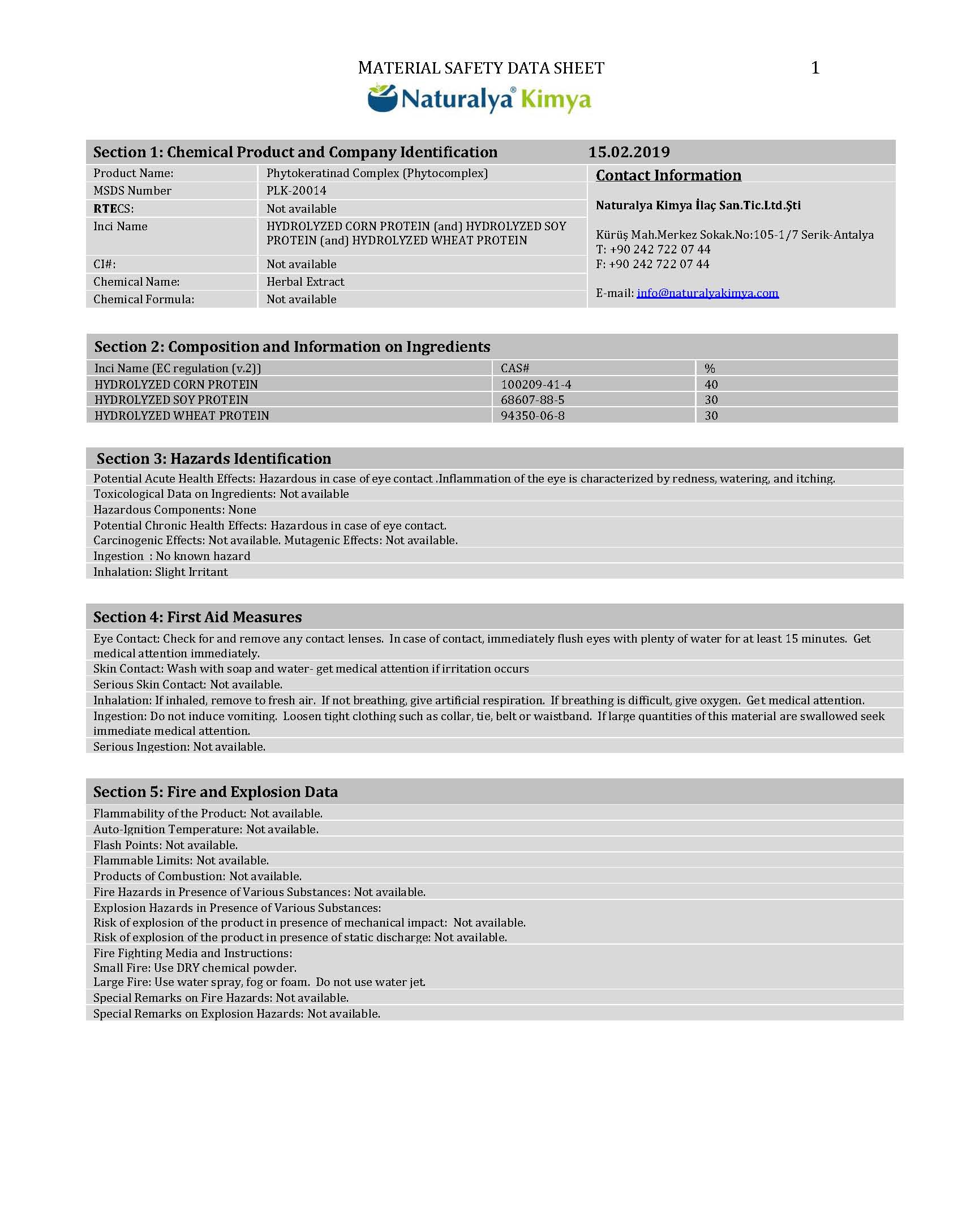
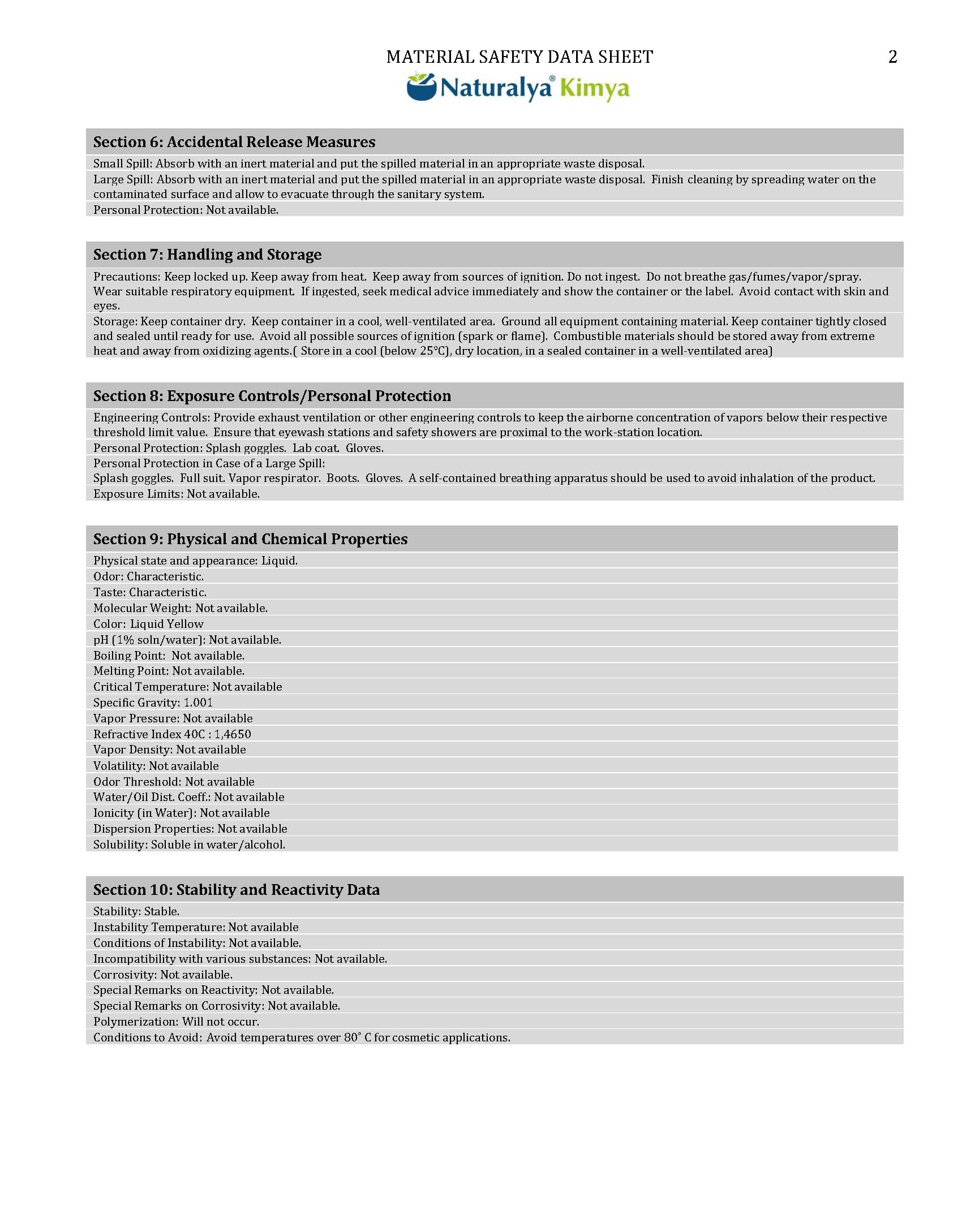
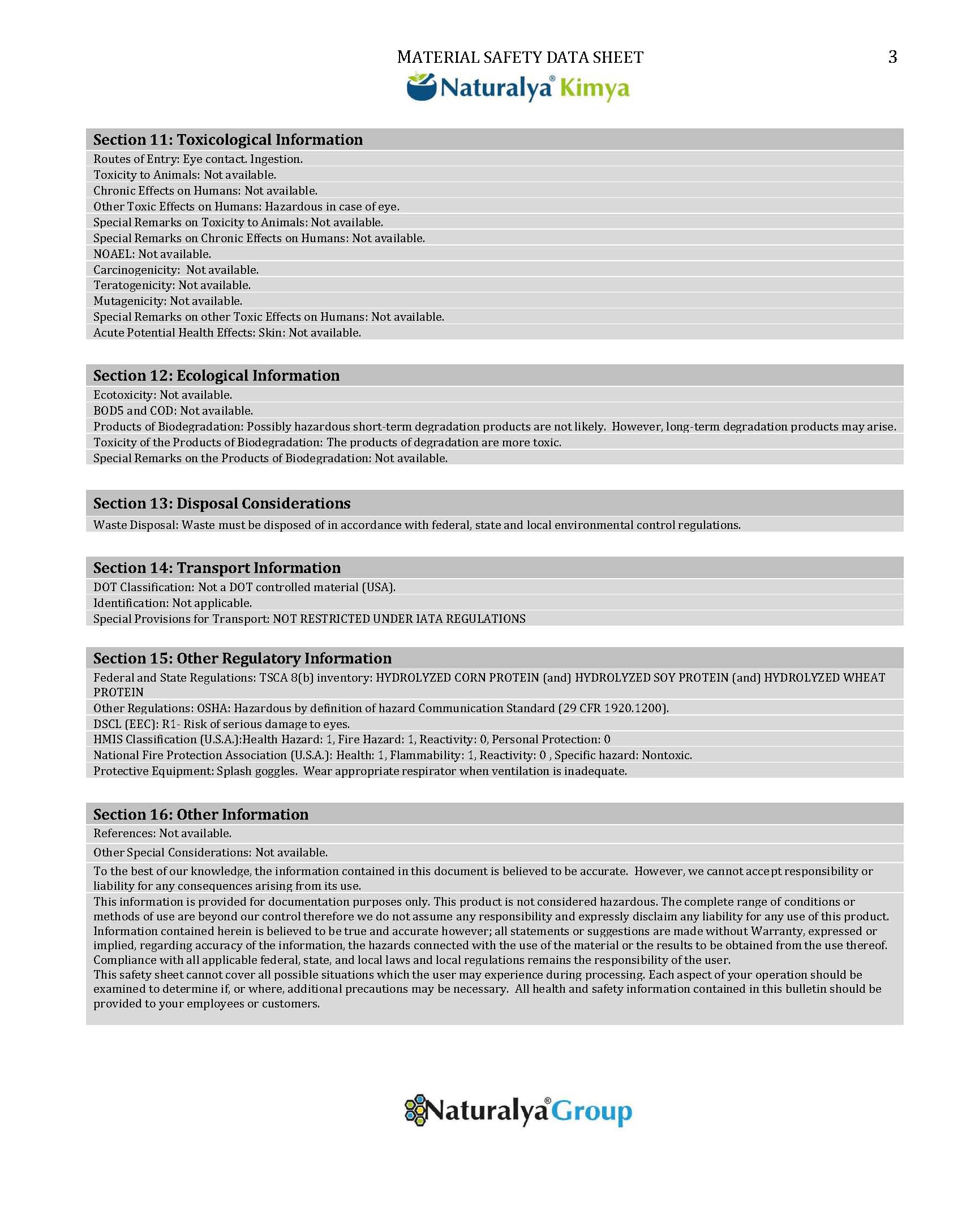
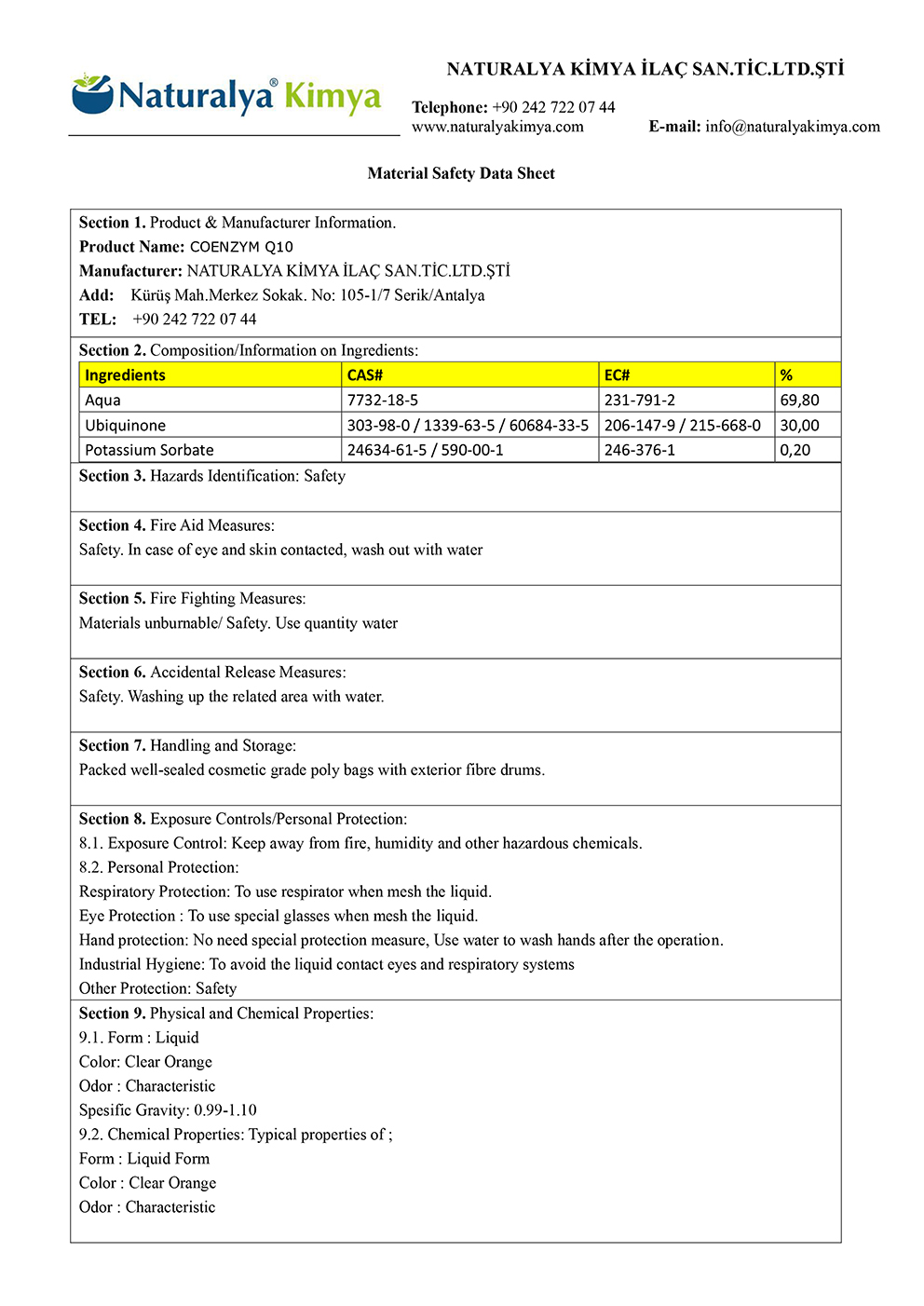
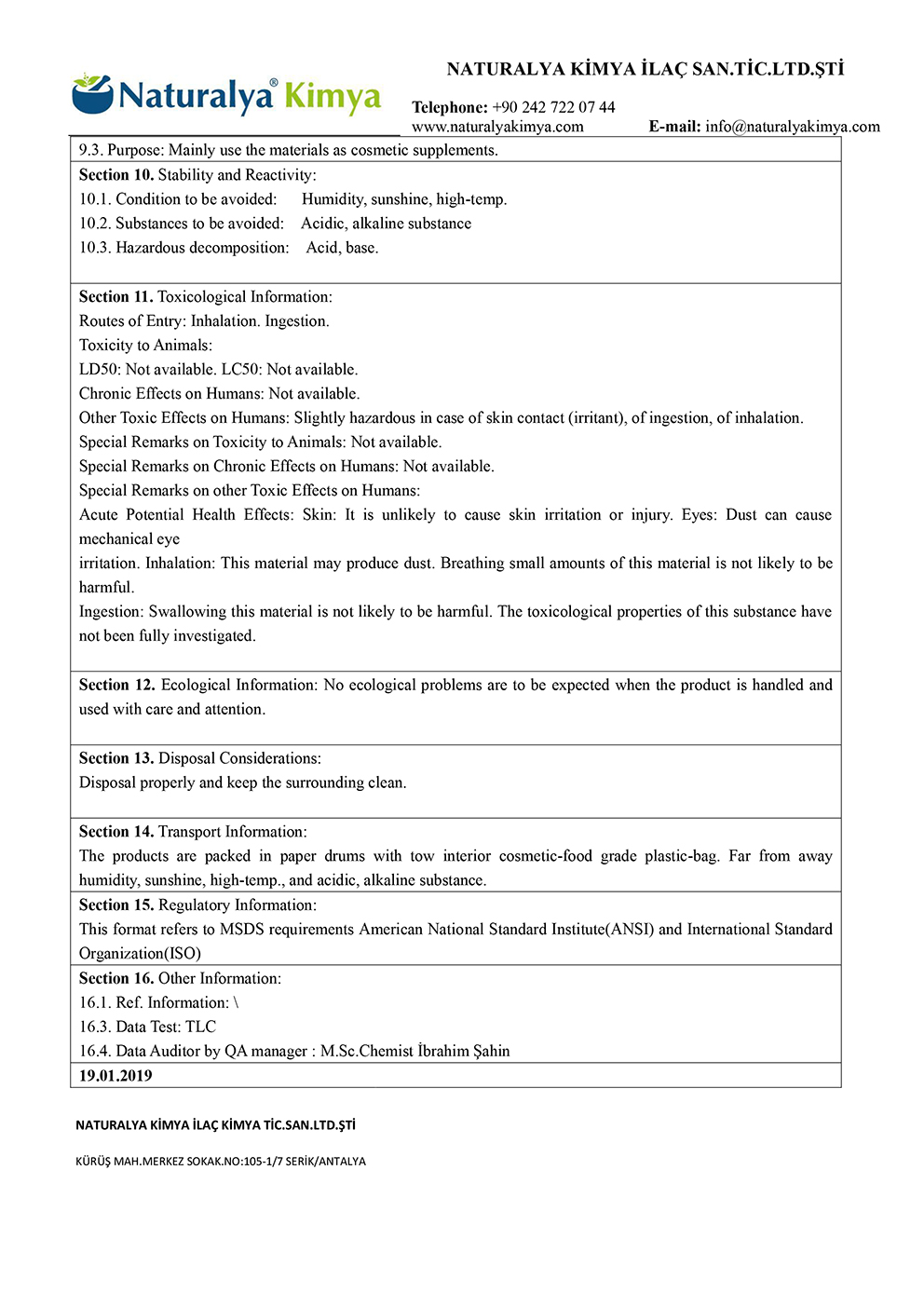




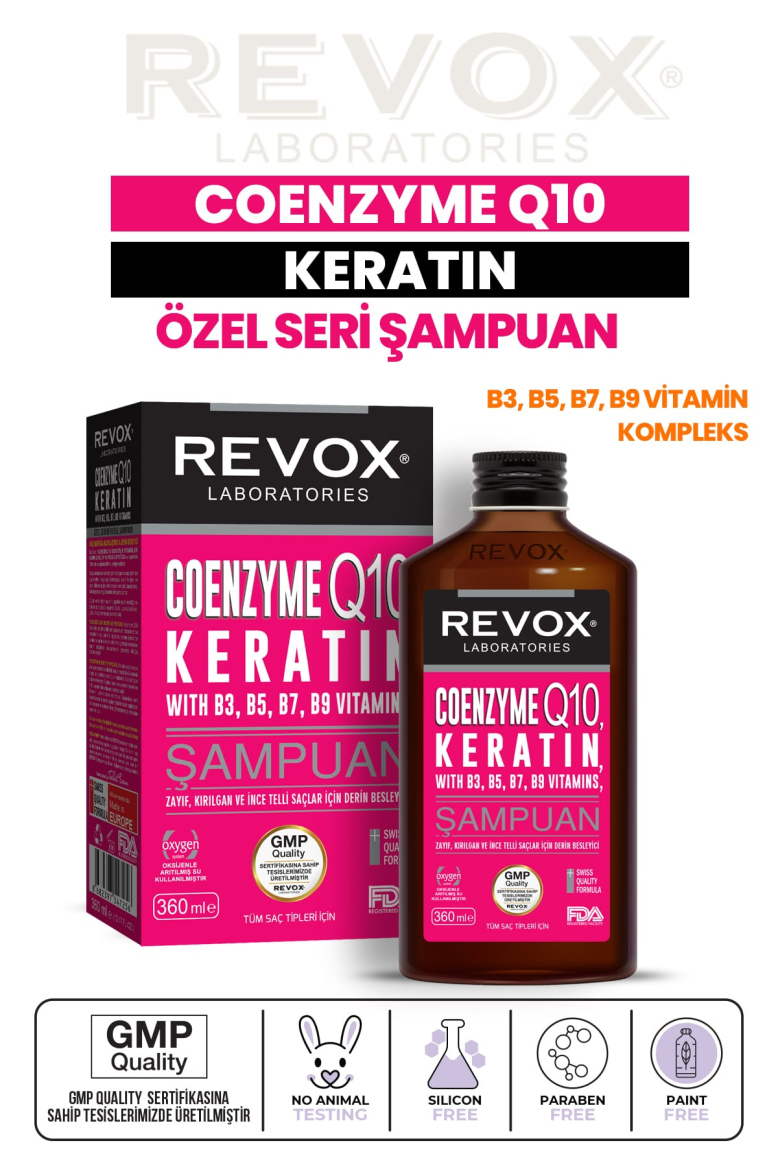
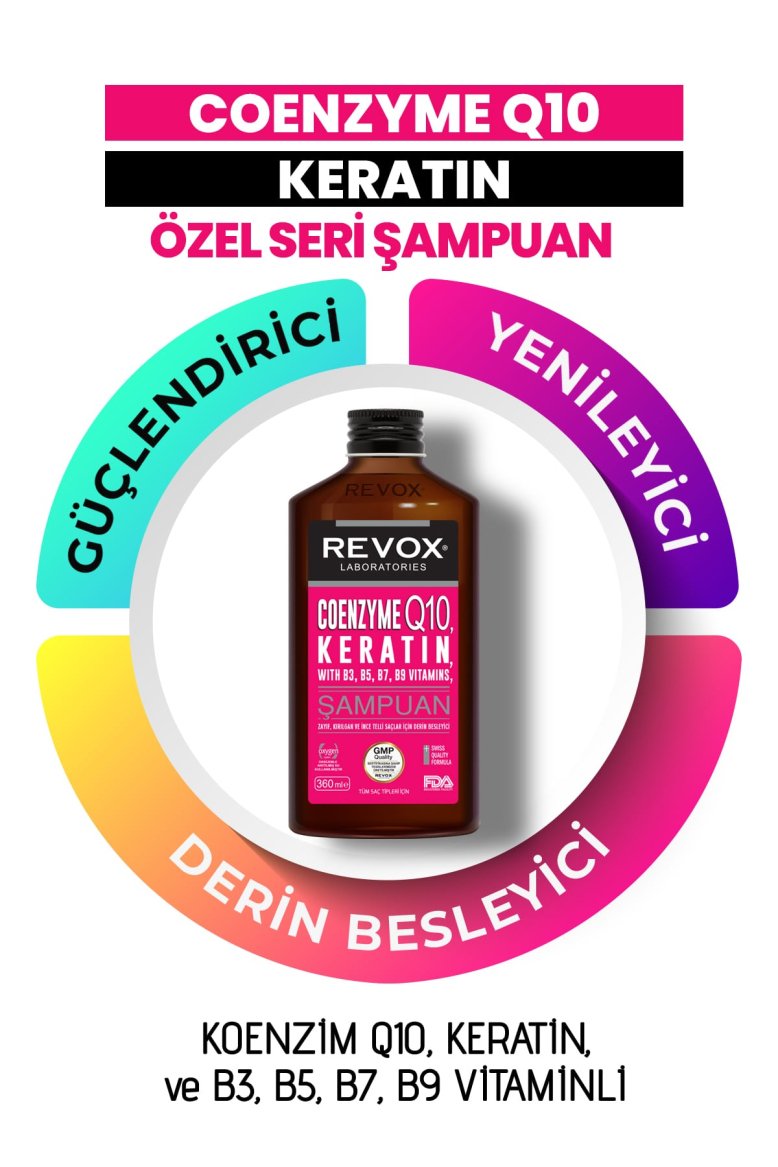
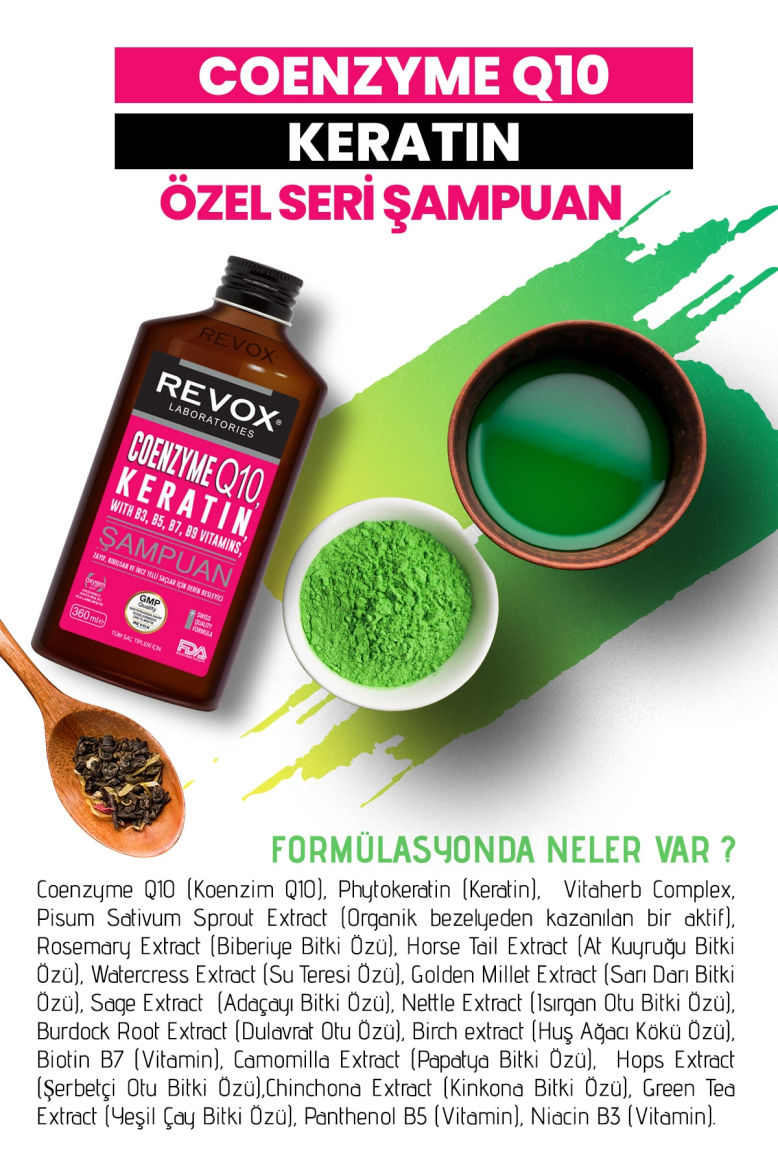
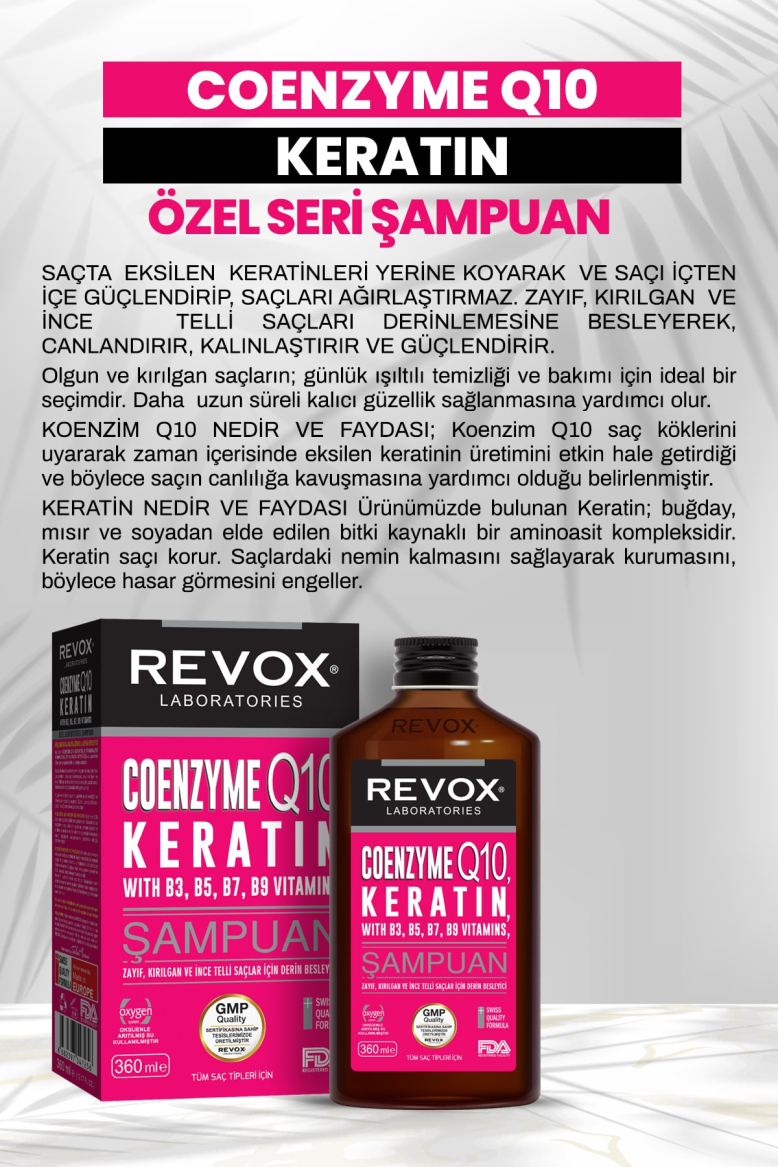
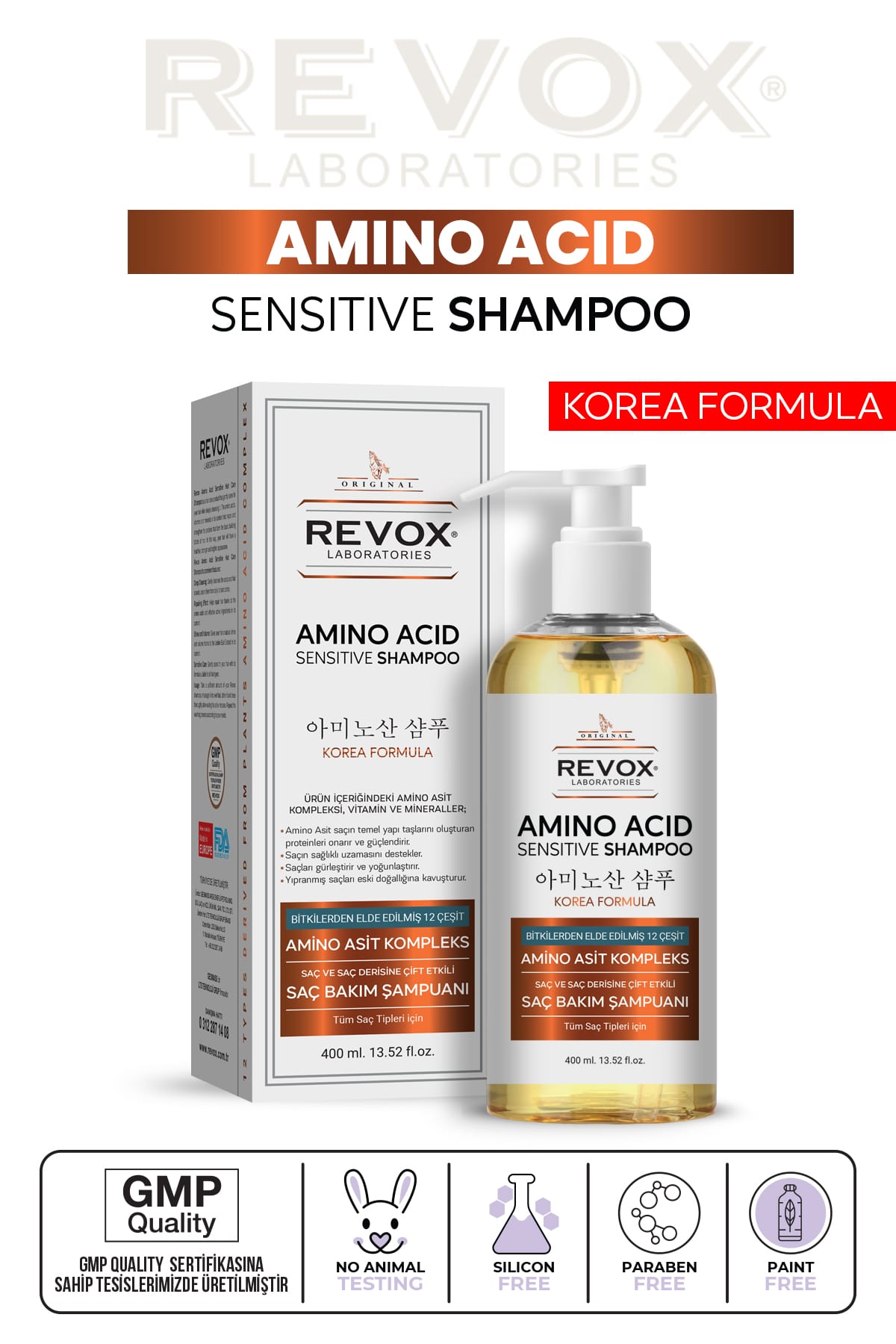

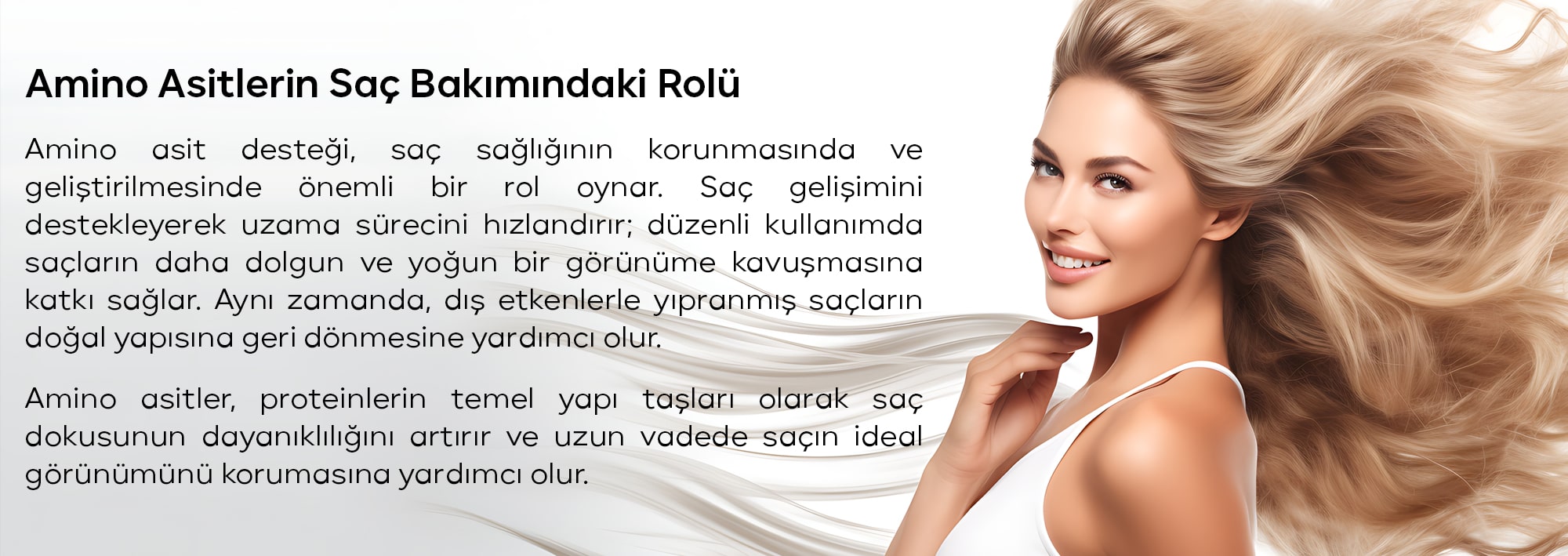


.jpg)



